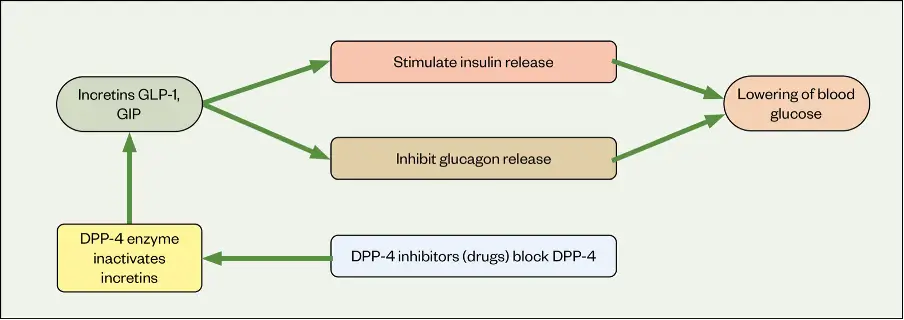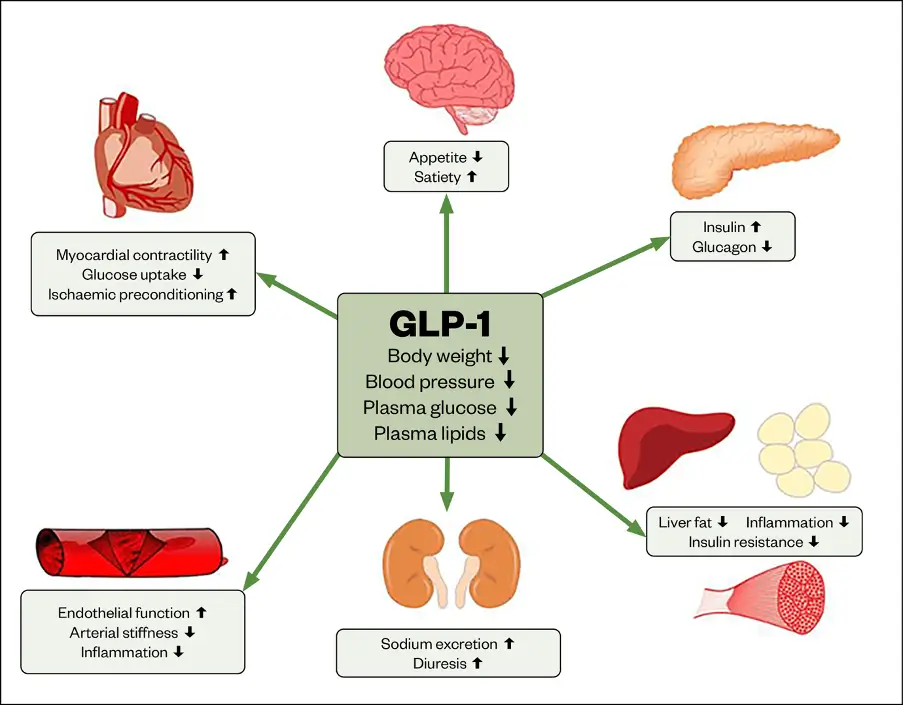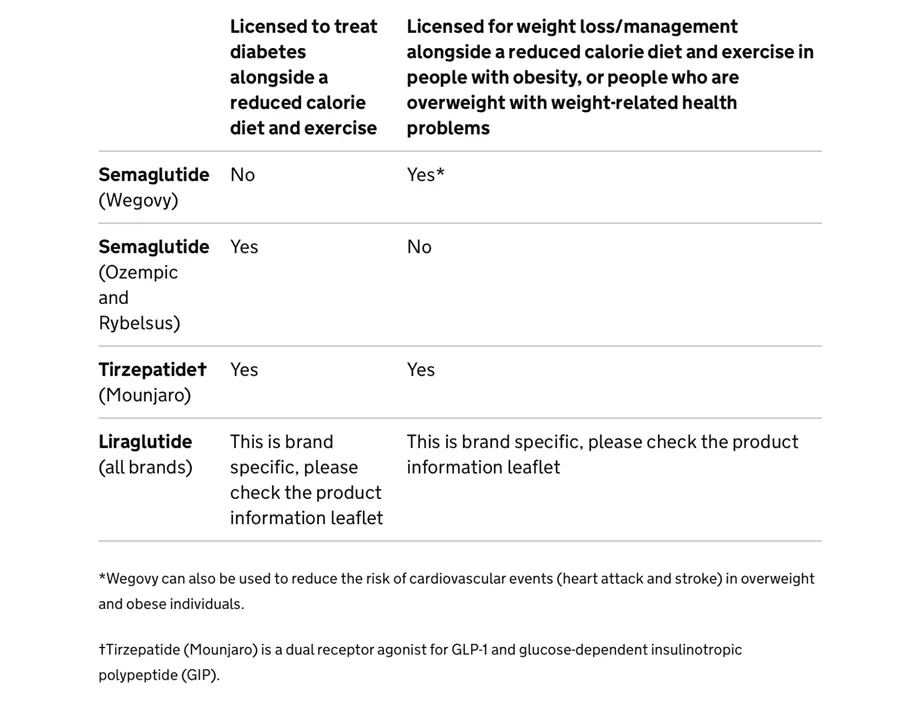GLP-1 in Clinical Practice: Beyond Glycemic Control
What is GLP-1
GLP-1, or glucagon-like peptide-1, is a peptide hormone produced in the intestines that plays a crucial role in regulating blood sugar levels and appetite. It’s classified as an incretin hormone because it stimulates insulin release from the pancreas after a meal, helping to lower blood glucose.
How Does GLP-1 Helps
Reduce Appetite
Reduces Heart Attack Risks
Lowers blood sugar levels
Helps in weight loss
Delays Gastric Emptying

Mechanisms by which GLP-1 analogues exert beneficial effects
How does GLP-1 Acts
GLP-1 and GIP are incretin hormones that enhance insulin secretion in response to oral glucose intake, a phenomenon known as the incretin effect.
These hormones are rapidly inactivated by the enzyme dipeptidyl peptidase-4 (DPP-4).
In type 2 diabetes mellitus (T2DM), the incretin effect is diminished or absent, contributing to impaired insulin secretion.
Pharmacological administration of GLP-1 (or its receptor agonists) can restore insulin secretion in T2DM.
Additional therapeutic benefits of GLP-1 receptor agonists include:
- Delayed gastric emptying, moderating postprandial hyperglycemia.
- Suppression of glucagon secretion from pancreatic α-cells when blood glucose is elevated.
- Reduction of β-cell apoptosis and promotion of β-cell proliferation, potentially preserving pancreatic function.

The effects of glucagon-like peptide in human physiology
Different types of GLP-1 Agonists

NICE Recommendations for GLP-1 to people with:
BMI of more than 30Kg/m2 (obesity)
BMI between 27 kg/m2 and 30 kg/m2 (overweight) in the presence of at least one weight-related comorbidity.
A lower BMI threshold (usually reduced by 2.5 kg/m2) has been recommended for people from South Asian, Chinese, and Black African or Caribbean family backgrounds.
Potential Risks and Benefits of GLP-1
Common Side Effects
- Loss of Appetite: Often intentional for weight loss but may lead to reduced caloric intake.
- Nausea: Frequently occurs, especially during the initial weeks of treatment.
- Vomiting: Common, particularly when starting therapy or increasing doses.
- Diarrhoea: A frequent gastrointestinal side effect that typically resolves over time.
Rare but Serious Risks
- Pancreatitis: Acute pancreatic inflammation, though uncommon, requires immediate medical attention.
- Acute Kidney Injury: Can occur, particularly in patients with pre-existing renal issues or dehydration.
- Worsening Diabetic Retinopathy: Rapid glucose lowering may exacerbate pre-existing eye conditions in some patients.
- Medullary Thyroid Cancer: A rare risk observed in animal studies, leading to caution in patients with a personal or family history of thyroid tumors.
Additional Considerations
- Gastrointestinal Intolerance: Side effects like nausea and vomiting may lead to discontinuation if not managed with dose titration or supportive care.
- Contraindications: GLP-1 agonists are not recommended in patients with severe gastrointestinal issues (e.g., gastroparesis), severe renal impairment, pregnancy, history of pancreatitis, or thyroid tumors, as these conditions increase the risk of adverse events.
Benefits
- Enhance glucose-dependent insulin secretion: improve postprandial insulin response.
- Suppress inappropriate glucagon secretion: reduce hepatic glucose output when blood sugar is high.
- Delay gastric emptying: slow down absorption of glucose, blunting postprandial glucose spikes.
- Promote weight loss: reduce appetite and food intake by acting on the hypothalamus.
- Preserve β-cell function: reduce β-cell apoptosis and may promote proliferation.
- Cardiovascular benefits: some agents have demonstrated reduction in major adverse cardiovascular events (MACE) in patients with T2DM and high cardiovascular risk.
- Potential renal benefits: some evidence suggests reduction in albuminuria and slowing of kidney disease progression.
Conditions for contraindications for GLP-1
Personal or family history of Medullary Thyroid Carcinoma (MTC)
- GLP-1 RAs carry a boxed warning (in the US) for risk of thyroid C-cell tumors.
- Although the data come from rodent studies and human risk is not proven, they are contraindicated in patients with a personal or family history of MTC or Multiple Endocrine Neoplasia syndrome type 2 (MEN2).
Multiple Endocrine Neoplasia type 2 (MEN2)
- Because MEN2 is associated with MTC, GLP-1 RAs are contraindicated.
Severe Gastrointestinal Disease
- GLP-1 RAs slow gastric emptying and can exacerbate gastroparesis.
- In patients with gastroparesis, severe GERD, or intestinal obstruction, these medications are usually avoided or used with caution.
History of Pancreatitis
- There have been reports of acute pancreatitis in patients using GLP-1 RAs.
- Although causality is debated, many guidelines advise against use in patients with a history of pancreatitis.
End-Stage Renal Disease (ESRD)
- Some GLP-1 RAs (especially exenatide) are contraindicated in severe renal impairment (e.g., eGFR <30 mL/min/1.73m²).
- Others (like liraglutide) may be safer but still require caution.
Pregnancy & Lactation
- Data are insufficient to establish safety.
- Generally not recommended in pregnancy insulin is preferred if glycaemic control is needed.
Hypersensitivity to the Drug
- Any prior severe hypersensitivity reaction (e.g., anaphylaxis, angioedema) to the drug or any of its components is a contraindication.
Caution is recommended in:
- Patients with severe depression or suicidal ideation (some post-marketing reports of mood changes exist).
- Elderly patients, due to higher risk of GI side effects and dehydration.
- Combination with insulin or sulfonylureas, due to risk of hypoglycaemia (though the GLP-1 RA itself rarely causes hypoglycaemia).

